The Researcher’s Apprentice: master’s students showcase innovative projects
Author: Attrayee Chakraborty
Date: 03.10.23
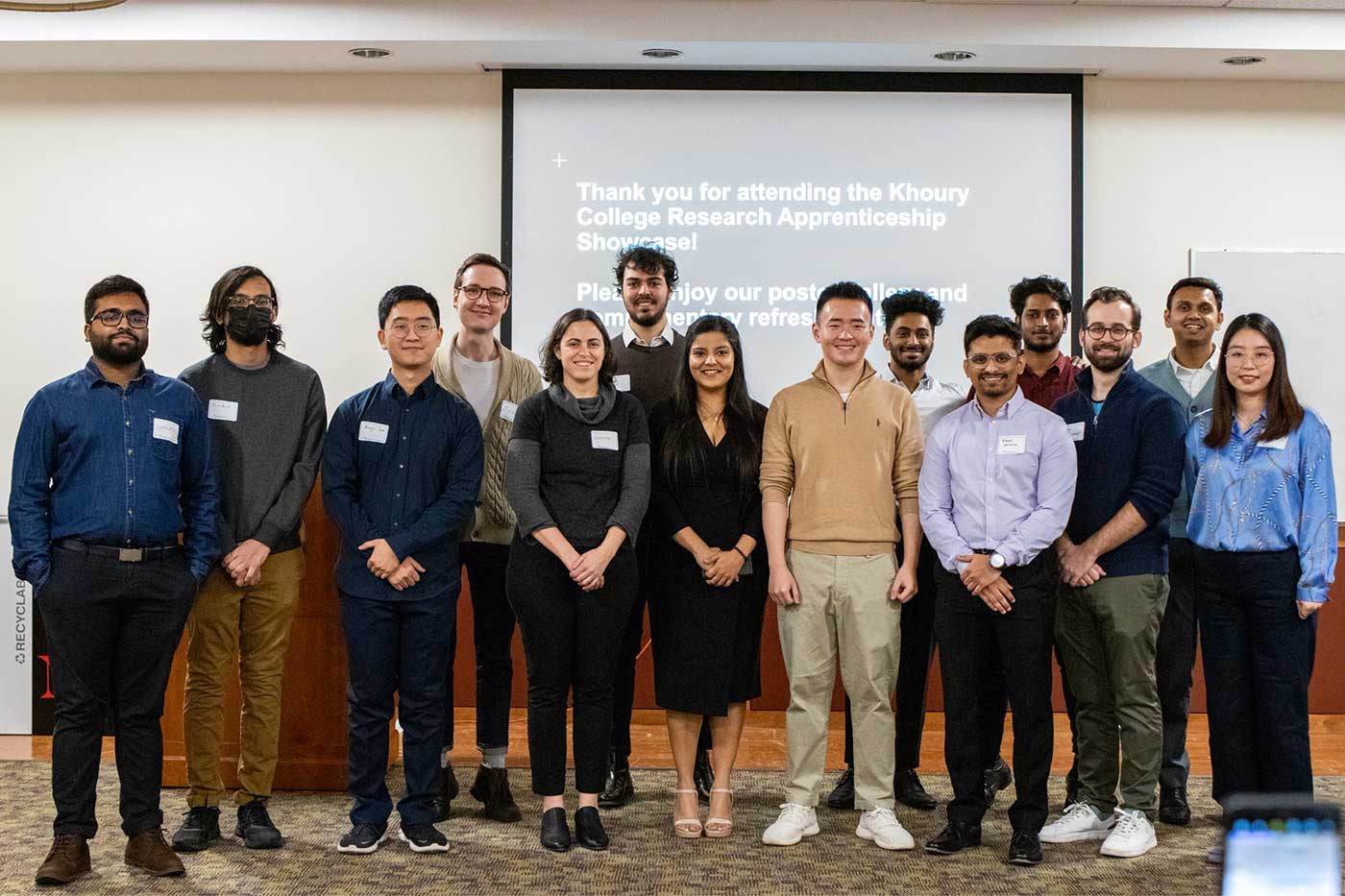 Photos by Miles Chun.
Photos by Miles Chun.
The Khoury Research Apprenticeship is a premier opportunity for master’s students to conduct research over a semester under the guidance of a faculty advisor. It also strives to cultivate potential doctoral researchers. In December, the program held its second showcase, where more than a dozen students presented their results. Click one of the names below to read about their project, or check out the program info here.
| Akash Shitole Caroline Craig Sumukh Vasisht Shankar Keith Rebello Mingxi Jia |
SzeYi Chan Charles Kirchner Shriya Dhaundiyal Jianhua Che Dmitrii Troitskii |
Akash Shitole
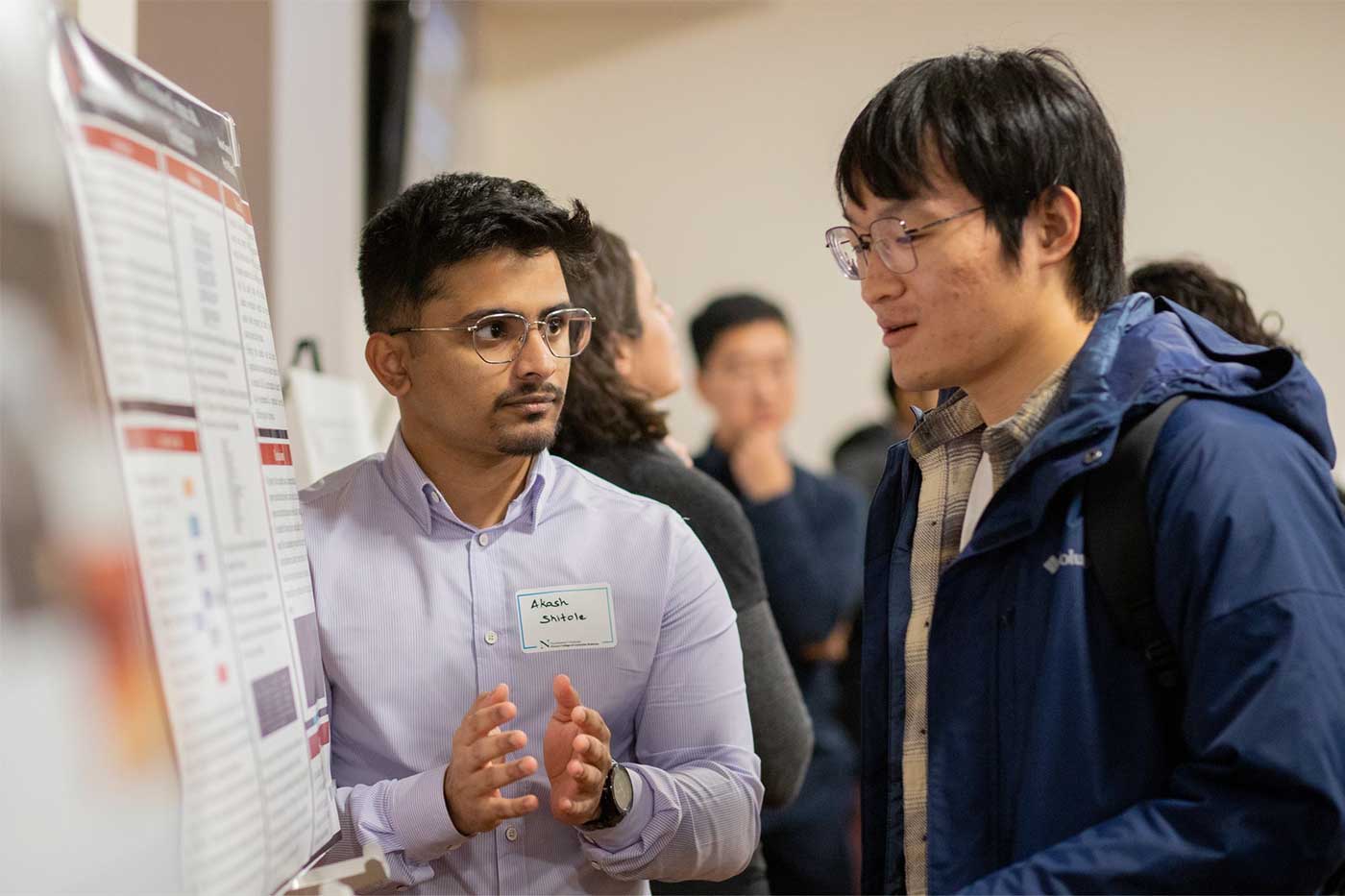
Akash Shitole’s cybersecurity passion stemmed from his undergraduate days, when he learned how data breaches paralyze institutions.
“Malware has creeped into our lives,” Shitole explains. “With so many data breaches and data theft going on around us, I believe that the future of computer science lies in malware capture and containment.”
Through his master’s program in cybersecurity and cloud computing, Shitole aims to use novel approaches to decimate command and control information stealers. While traditional procedures treat systems after they’re breached, Shitole’s unconventional approach searches for traceable malware fingerprints to detect malicious activity in real time. “This can fix the problem of current approaches where we stop using systems altogether once a breach occurs,” Shitole says.
However, creating a hack-proof end-user system was difficult. Shitole had to create an isolated testing environment to run his programs and resolve version incompatibility before he could implement his approach against different kinds of malware.
“With the help of Professor William Robertson and Khoury College’s supportive research culture, I surmounted most of my challenges,” Shitole says. “I feel more passionate about solving real-world problems than ever before.”
Caroline Craig
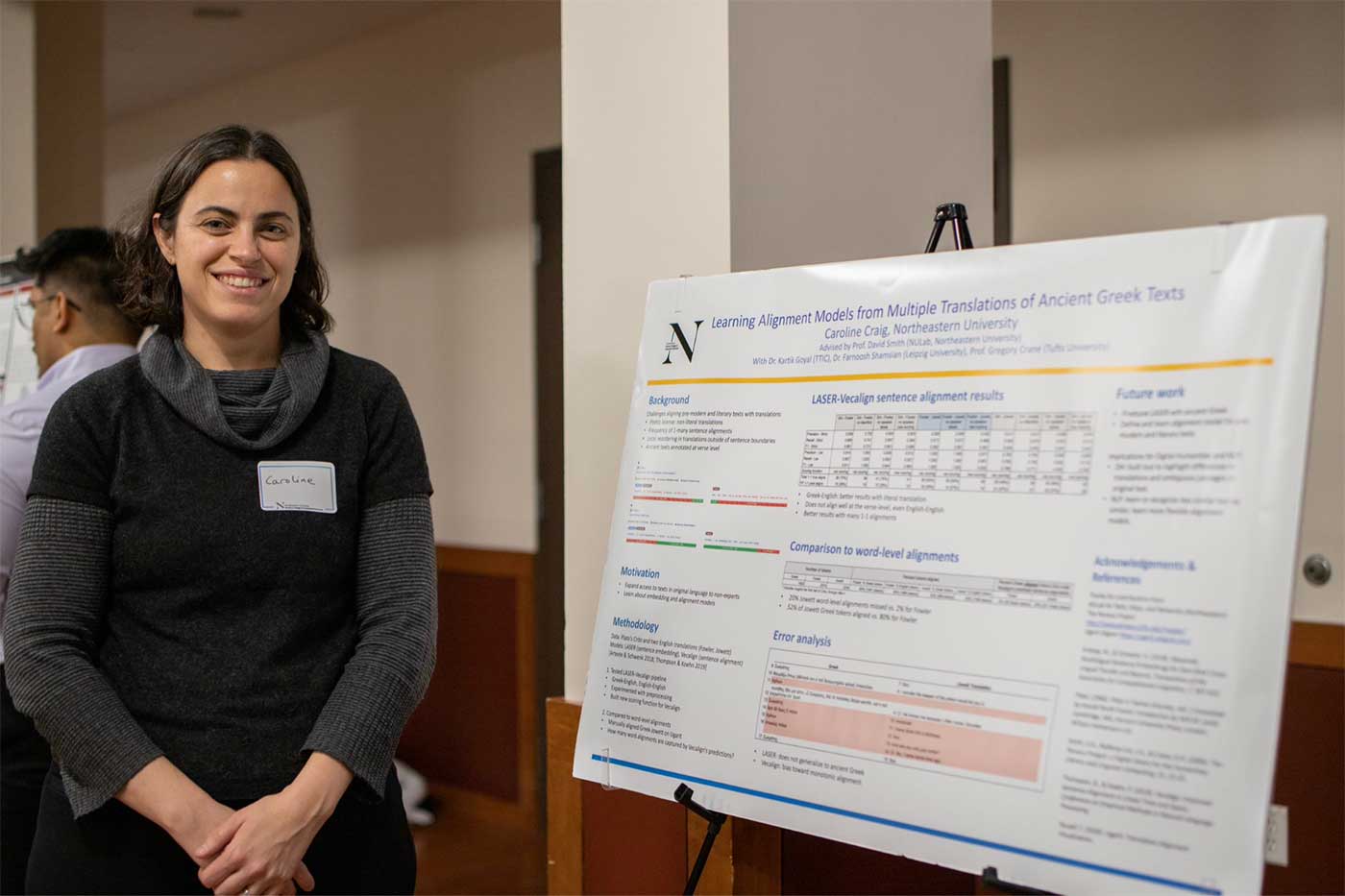
Caroline Craig brings a unique background to her data science master’s program.
“As an undergrad, I was passionate about classics, so I was excited to have an opportunity to study alignment models,” Craig says. “Ancient Greek text is an unusual data set to use, and using it would allow us to poke at natural language processing (NLP) models to see what works and what doesn’t.”
In her project, Craig tested two NLP models to see how they interpret this unconventional text. Her results are guiding her research questions this spring as she strives to build a better NLP model for documenting and preserving ancient languages, and see what other alignment models can be used to perform NLP.
“Learning new models, working on research code, running code on a cluster, and most importantly, taking ownership of a research agenda helped me grow into a better researcher,” Craig reflects. “I am thankful to Khoury College for giving me the chance to present research in an academic environment, a required skill in the PhD that I am considering.”
Sumukh Vasisht Shankar
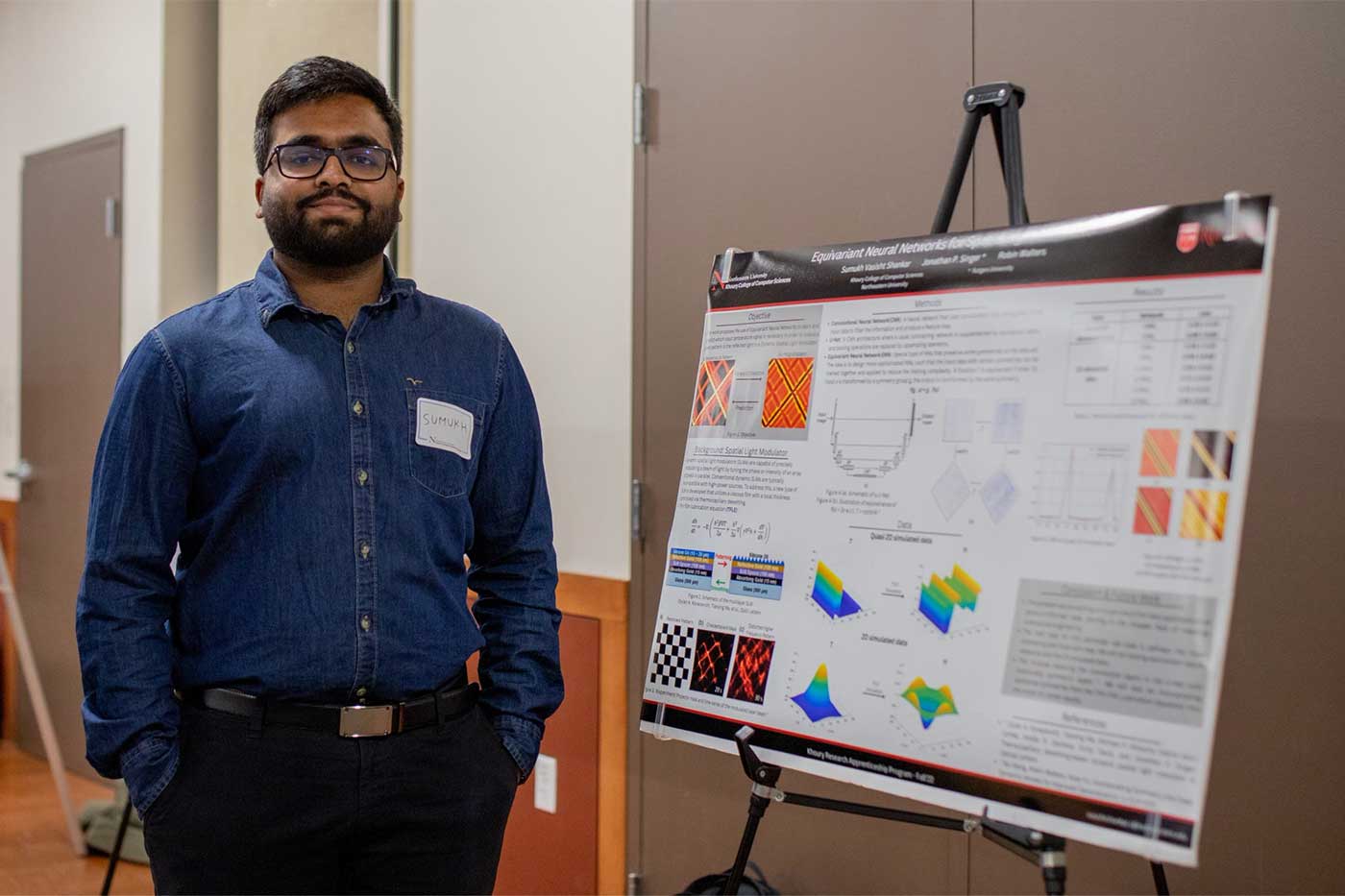
In pursuing his master’s in data science, Sumukh Vasisht Shankar has incorporated his lifelong interest in physics. He gravitated towards using deep learning to control light patterns in spatial light modulators (SLMs), and for his apprenticeship project, he trained models to generate temperature patterns required for producing a light pattern in an SLM.
“Heating an oil film changes the thickness of the oil film, resulting in a change in the phase and intensity of the beam of light which shines over it,” Vasisht Shankar elaborates. “But conventional SLMs working on this principle don’t work well with high-power sources like lasers. We want to work on forming physics-informed deep learning models that can learn what temperature is needed to induce a given pattern of light.”
Vasisht Shankar used a fourth-order differential equation to simulate data, which proved daunting.
“Carrying out real experiments is expensive,” Vasisht Shankar says. “Equations have boundary conditions and are computationally difficult, so we relied on deep learning to eliminate the need for these boundary cases.”
Vasisht Shankar’s future is bright, figuratively and literally; he plans to use data from his apprenticeship research to train neural networks in real-world settings to create desired light patterns. With his knowledge in data science from Khoury College, Vasisht Shankar is confident in pursuing a PhD in physics-informed deep learning.
Keith Rebello
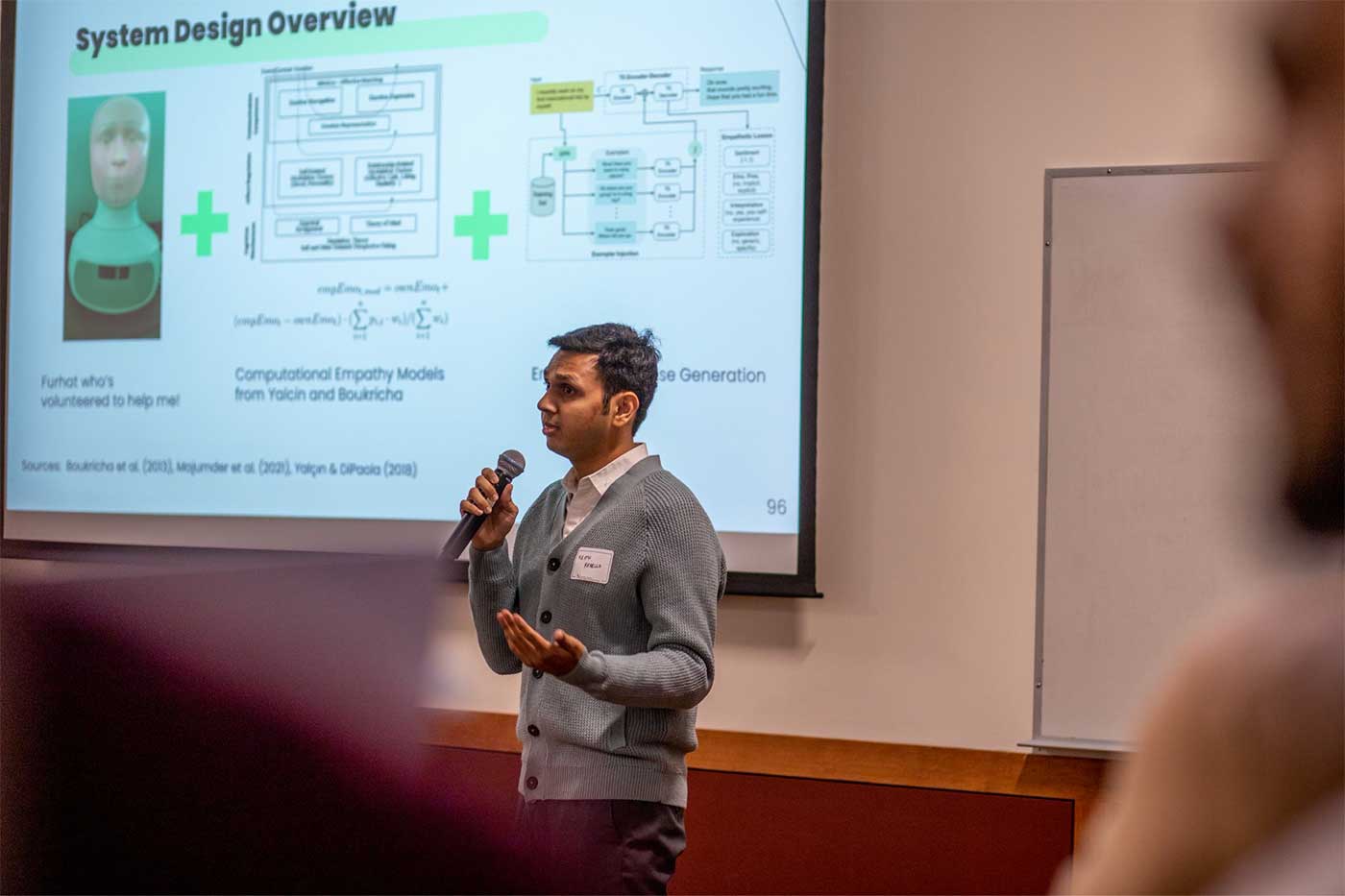
As part of his master’s in artificial intelligence, Keith Rebello is trying to solve one of the field’s most enduring problems: the need for empathy in robots.
“I studied mental health as a minor in my undergraduate degree, and I always had a passion for artificial intelligence,” Rebello says. “Coming to Khoury College to study artificial intelligence paved my way to working with the Relational Agents Group headed by Timothy Bickmore, where I have been teaching robots empathy so they can have a better conversation with you.”
Rebello’s project focuses on teaching robots to handle emotionally charged situations — such as dementia patients who require constant attention — while keeping the user’s feelings in mind.
“It was difficult to find a consensus definition of empathy and synthesize existing models of empathy into an empathetic response generator,” Rebello says. “But now that I am almost done building the system, I plan to test it with people to see whether it actually helps them.
“I plan to continue research in social robotics and empathetic conversation agents through a PhD,” Rebello adds. ”I am confident that I’ll enjoy working in research, given that I had such a positive experience testing my ideas through Khoury College’s courses, apprenticeship, and unique opportunities.”
Mingxi Jia
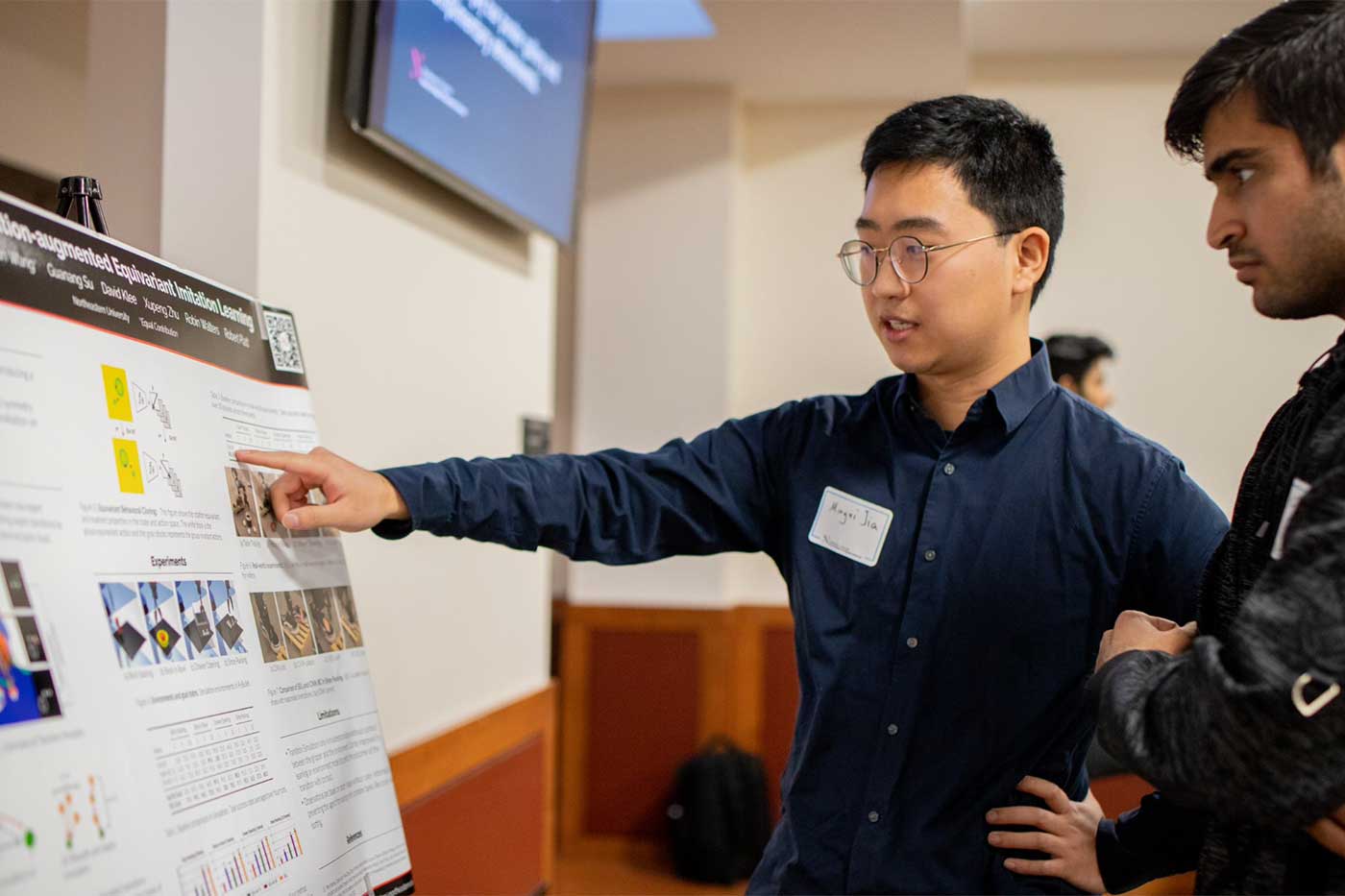
Mingxi Jia’s journey in combining machine learning and robotics started with a video that his grandmother sent him.
“The video predicted low-cost domestic robots in five years, but my inner robotic researcher knows that we have a long way to go in transforming such dreams to reality,” Jia explains. “That got me wondering: can we train robots to perform skills in an easier way using smaller data sets?”
During his master’s in robotics and computer science, Jia observed that industrial robots require careful calibrations and specially designed programs to work. He was also exposed to a low-cost technique called imitation learning — which aims to train a robot to mimic a set of demonstrations given to it — at the Helping Hands lab, so called for its mission to build robots for domestic tasks.
“We want to use the commonalities in routine tasks to train robots to make decisions and tackle objects,” Jia says.
Additionally, Jia studied ways of extracting more information from demos given to robots, namely by introducing a novel 3D data augmentation technique and taking advantage of symmetries in robotics. But the challenges were formidable, especially calibrating a real robot which had much more noise than a perfect simulation, and developing a new program to collect the data.
Jia’s paper has been accepted by the Conference on Robot Learning’s Workshop on Sim-to-Real Robot Learning: Locomotion and Beyond, and he’s looking forward to presenting his ideas at the 2023 IEEE International Conference on Robotics and Automation. He also hopes to continue learning how to improve robotic performance through a PhD.
SzeYi Chan
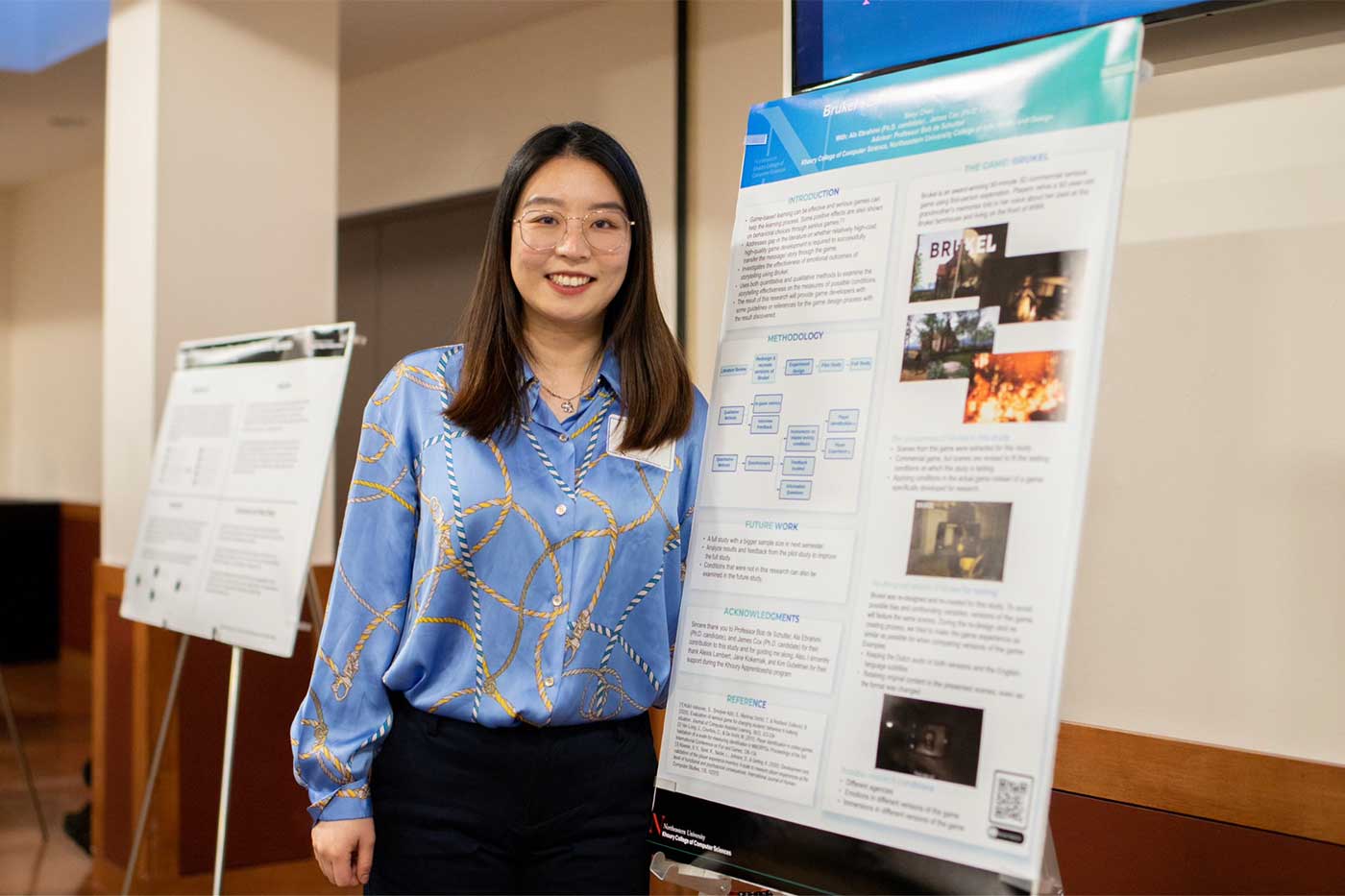
After earning an undergraduate degree in economics, SzeYi Chan ventured into data analysis — mostly using Microsoft Excel — in a sales and marketing company to understand consumer behavior. When she discovered that data analysis could be much easier if she knew coding, Chan enrolled in Align, Khoury College’s master’s program for students who studied non-CS subjects as undergrads. Within her computer science degree, she took an interest in human-computer interaction (HCI), a multidisciplinary field that focuses on the design of computer technology.
“I have always wanted to understand the factors behind people’s behavior, and HCI seemed like my calling, as it aims to study what can be done to improve it. Then while I was looking for HCI projects, I came across Bob De Schutter’s project,” Chan says, referring to Brukel, a first-person exploration game De Schutter developed based on his grandmother’s experience during World War II. “Once I found a research apprenticeship with a professor who had a commercial game on Steam, it felt like a dream come true!”
Chan began her apprenticeship by exploring HCI in gaming and game-based learning.
“However, we found limited literature on what makes these games so efficient in improving educational learning and cognitive skills,” Chan recalls. “We decided to explore the determining factors that made the storytelling so effective, specifically the high cost and quality of these games.”
READ: Armed with a video game, Khoury College researchers turn amateurs into scientists
“After finishing pilot studies during this apprenticeship, I plan to publish a paper before going on to a PhD,” she adds. “Games are a small part of HCI, and I want to explore more of what Khoury College has to offer!”
Charles Kirchner

“When I saw the apprenticeship program, I knew I had to apply,” computer science student Charles Kirchner says. “My experience with Chris Amato in reinforcement learning made me value and understand research, and how unconventional paths lead to success.”
In his apprenticeship, Kirchner combined two reinforcement learning strategies: macro action reinforcement and value decomposition. Conventionally, macro action reinforcement learning trains AI systems to decide between high-level pathways and reduce complexity, while value decomposition improves coordination between multiple learners.
“A joint evaluation of decisions could improve outcomes of decision-making in artificial intelligence,” Kirchner explains. “Preliminary outcomes show promising results of improvement in AI system coordination.”
Kirchner joined Flexcar as a back-end software engineer after graduation. But he says he’ll continue mixing and matching tools to help AI learn better, and hopes his team explores the intricacies of this novel approach.
Shriya Dhaundiyal
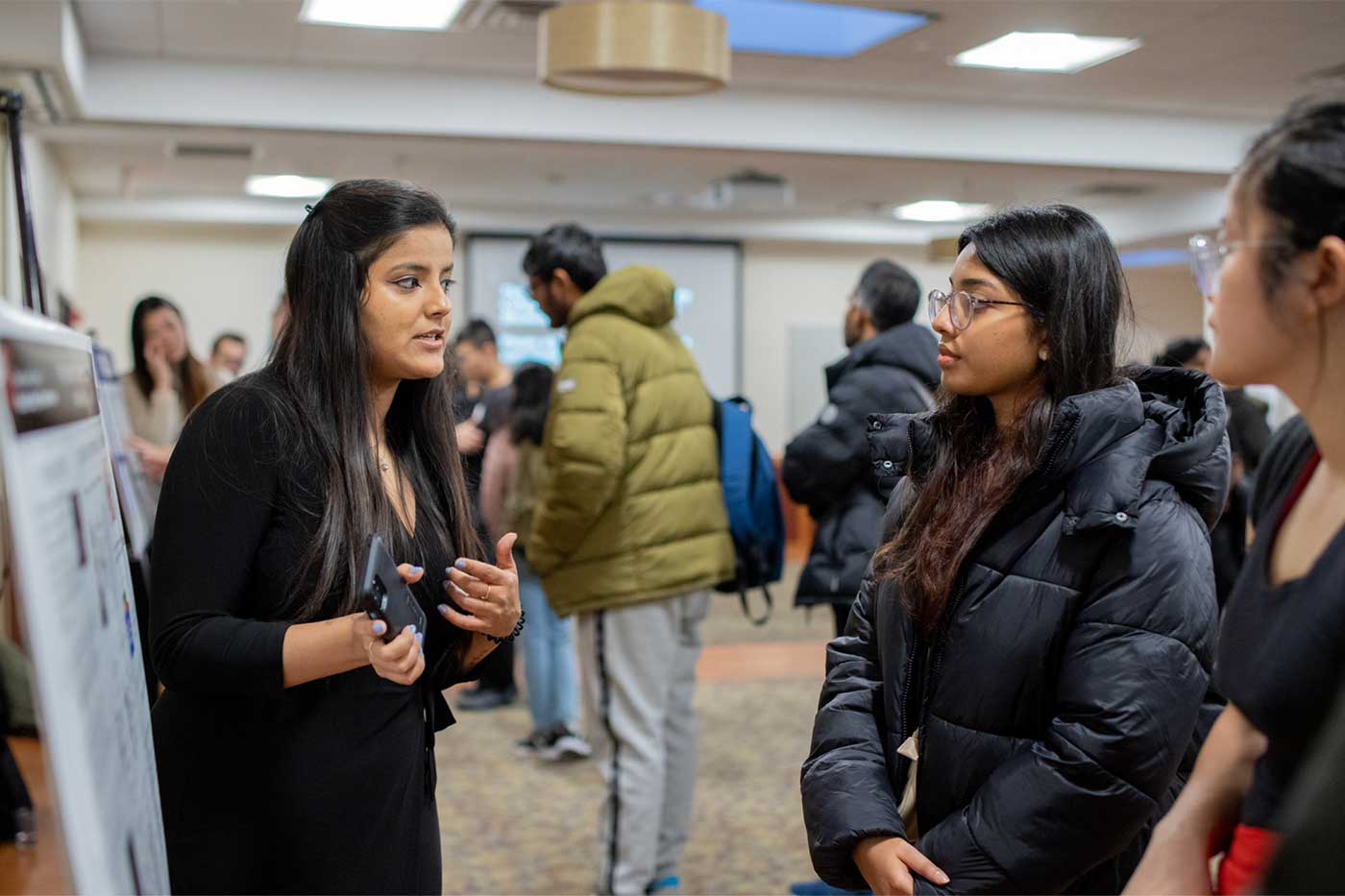
“After studying dental surgery during my undergrad, I decided that I wanted to get involved in med-tech research,” says Shriya Dhaundiyal, now a computer science student in the Align program. “With so many privacy breaches in the healthcare sector, it seemed natural to explore how our data is used by the tech we use on a daily basis.”
During her apprenticeship with David Choffnes, Dhaundiyal investigated voice-based AI systems such as Alexa, Siri, and Google Assistant to determine whether they profiled users based on their interactions. Dhaundiyal’s results supported her hypothesis, and she’s looking to confirm them by reproducing her experiments at scale.
Dhaundiyal’s project helped her identify a lot of red tape. Every big tech company has its own privacy policy, and looking at how those policies account for profiling activities demands an understanding of nuanced legal declarations.
As a personal challenge, Dhaundiyal found it adventurous to shift from hardcore healthcare to technology.
“I can’t wait to collaborate with people on tech privacy,” Dhaundiyal says. “I appreciate how Khoury College has introduced me to viewing things differently. The unique and inspiring ideas of professors spur me on to create an impact on the world.”
Jianhua Che
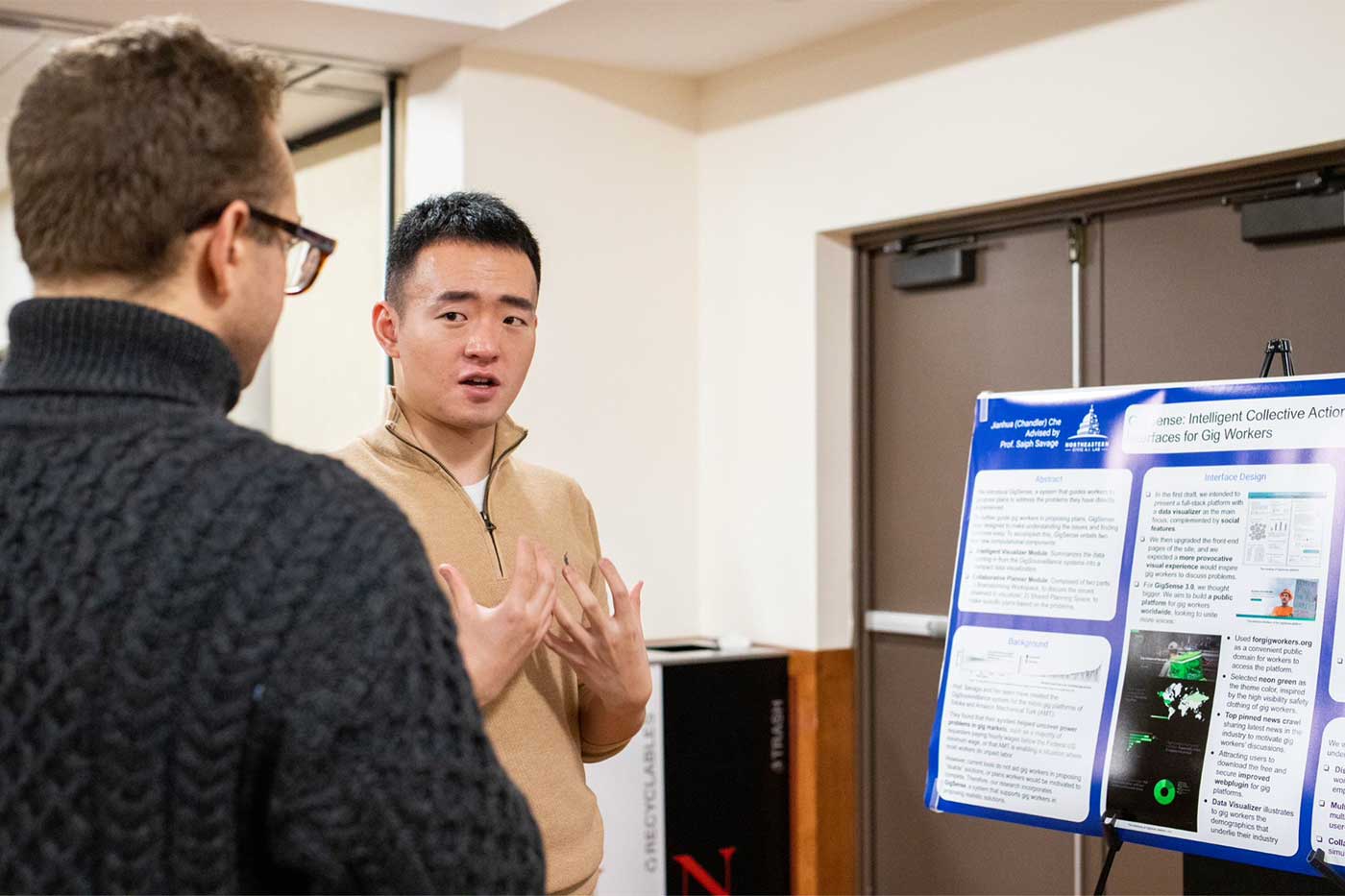
Jianhua Che can envision his revolutionary dream already: millions of gig workers of the world uniting and using data to claim what they deserve. An Align computer science student, Che leveraged a web plug-in built by his advisor, Saiph Savage, to collect data provided by gig workers, model their wages and hours worked, and determine whether those workers are fairly paid given current economic conditions. He aims to design social computing systems and intelligent collective action tools, which gig workers can use to demand better compensation and working conditions.
“A majority of gig workers are earning below the US federal minimum wage, and many big gig platforms like Toloka and Amazon Mechanical Turk are enabling a situation where most workers do unpaid labor,” Che says. “In response, I developed GigSense, a platform for gig workers to speak out about their work conditions.”
The main challenge was guiding gig workers in proposing plans with collective action tools. By achieving this, Che aims to bring human-centered AI tools to the gig market to help workers evaluate their benefits, voice their concerns to management, and achieve a better quality of life.
“I love designing social computing systems,” Che says. “It adds meaning to my life.”
Dmitrii Troitskii
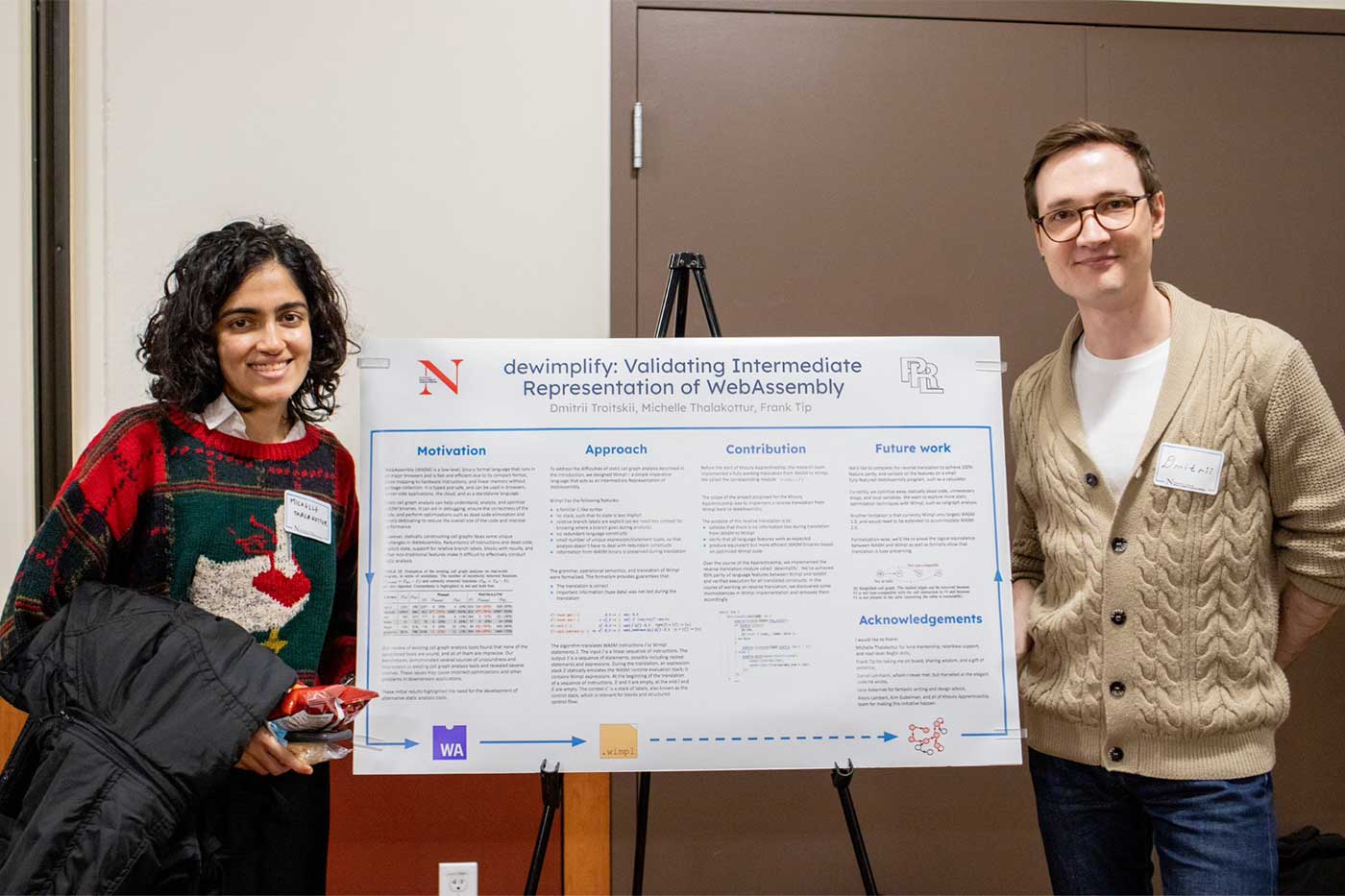
After participating in a coding bootcamp, Dmitrii Troitskii pivoted from technical project management to the Align computer science program.
“I realized my passion lay there,” Troitskii says. “I wanted to explore computer science both as a career opportunity and as something that would make me curious.”
When Troitskii found a project related to programming languages, he decided to join the apprenticeship, where he worked on static analysis of WebAssembly. The team, led by Michelle Thalakottur and Frank Tip, optimized WebAssembly by designing Wimpl, an intermediate language. Wimpl can help with finding errors in code, streamlining code by excluding unused features, checking code for security flaws, and optimizing programs.
“We named the project ‘Dewimplify,’” Troitskii says. “It’s like a circuit: we are ‘wimplifying’ from Web Assembly to Wimpl, and ‘dewimplifying’ as we go the reverse direction.”
The project aspires to translate WebAssembly code to Wimpl, conduct static analysis, and then translate the optimized code back to WebAssembly. WebAssembly presented an interesting challenge; for example, it stores all the values on a stack instead of the registers that most languages use. Troitskii hopes that this project will reduce the burden of running complicated programs.
“We have been testing with small programs, and would like to test medium-sized programs — a calculator, for example,” he says. “We want to take these programs, optimize them using Wimpl, and see how their performance improves.”
Subscribe to Khoury News
The Khoury Network: Be in the know
Subscribe now to our monthly newsletter for the latest stories and achievements of our students and faculty